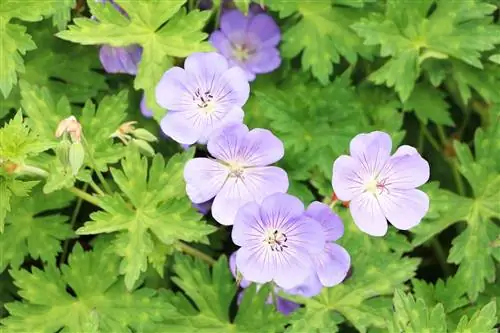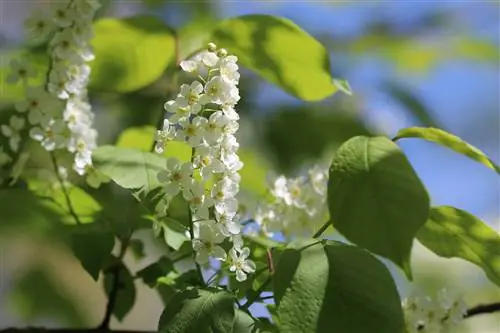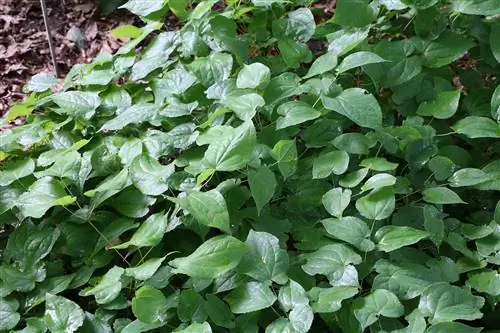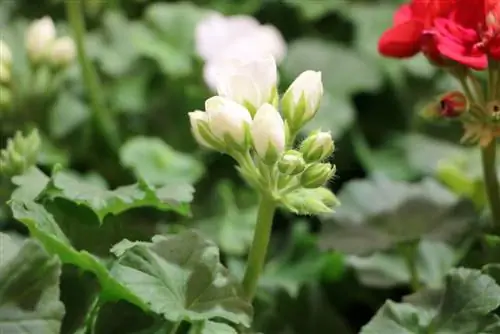- Author admin [email protected].
- Public 2023-12-17 03:39.
- Last modified 2025-06-01 06:48.
The cranesbill is a very undemanding and easy-care plant. Ideal for working people, older people, and for large gardens, as it generally tolerates drought well, although it feels more comfortable in moist, humus-rich, loose soil. Waterlogging should definitely be avoided (risk of rot). The ideal location for cranesbills is light shade, sun but also a woody edge, or in the vicinity of roses and other tall-growing perennials. The location required for each plant varies from variety to variety.
Storksbills grow to a height of 15-120 cm depending on the variety. The flowering period is from May to September depending on the variety. Pruning after the first bloom encourages a second, and sometimes a third, bloom. Some varieties are wonderful as ground cover; they reproduce through runners and thus suppress unwanted weeds. Ground-covering cranesbills are best planted in heathland and natural gardens, where they can spread undisturbed.
Care
The range of flower colors and shapes is wide. It ranges from white with pink stripes (Geranium cantabrigiense), to blue, double (Geranium Birch Double), purple to red-violet (Geranium macrorrhizum), to brownish-purple (Geranium phaeum).
Many (but not all) species are hardy in our latitudes, some are even wintergreen (Geranium riversleajanum Russell Prichard). Some varieties change their leaf color to a bright red. A wonderful sight in autumnal gardens. This color lasts until the first frosts. Propagation can occur via division, cuttings and sowing. Some varieties are also suitable for keeping in containers (especially non-hardy varieties) and for hanging baskets.
Stork's beak is absolutely free of pests and diseases and is also avoided by snails. The plant carries pollen and may therefore not be suitable for allergy sufferers. Cranesbills are very popular exchange objects in forum communities and in plant exchange circles. The variety of varieties contributes a lot to this popularity. In autumn and spring it is worth looking specifically for these plants at plant exchanges. This is how you can find one or two rare species.
Profile
- Species/Family: Perennial. Belongs to the cranesbill family (Geraniaceae)
- Care effort: Low. Easy to care for, uncomplicated and frugal
- Flowering time: Depending on the variety, from May to October in white, pink, violet, blue or red
- Foliage: Palmate, deeply divided leaves in fresh, strong green with beautiful reddish autumn color. Aromatically spicy smelling. Some species also have gray-green or blue-green foliage
- Growth: Ground-covering, bushy, compact growth. Spreads through runner formation
- Height/width: 10 to 60cm high and 40 to 50cm wide
- Location: Sunny to partially shaded. Dry, permeable soil, some species also cool moist soil, for example at the edge of the pond. Most people like to be in front of and between trees
- Planting time: Any time as long as the ground is not frozen. Can be sown in spring
- Cut: Very compatible with cutting. Cut back close to the ground in spring before new growth
- Partner: Fits nicely into the perennial bed
- Propagation: Division before or after flowering. Seeds can also be collected and sown elsewhere
- Care: Do not overwater most species. Fertilization not necessary for most species
- Overwintering: Hardy except for geraniums
- Illnesses/problems: problem-free
Special features
- Exudes a natural charm that fits well into a natural garden
- Good and durable cut flower
- Is also an ornament outside of the flowering period thanks to the decorative, spicy-smelling leaves and the extraordinary autumn color
- The balcony plants that we commonly sell as geraniums are actually called pelargoniums and are just one of the many cranesbill species
- Extra tip: Large, overgrown areas can hardly be cut by hand, so simply use a grass trimmer
Species
Blood cranesbill (Geranium sanguineum)
Apart from the geranium, the most famous species. Height 10-50cm. Blooms mostly from May to September, with peak flowering in May and June, with cup-shaped, crimson, pink or white flowers. Broad-growing, with shoots spreading across the ground and quickly overgrowing other plants and objects such as stones. Sunny to hot dry location is preferred. Only water during long periods of drought. Perfect partners are grass lilies. To stop the spread you can cut back at any time
Rock Cranesbill (Geranium macorrhizum)
Height 20-30cm. Blooms from May to July with delicately fragrant, plate-shaped flowers in light pink, pink or white in several clusters on branched flower stalks. Leaves have a particularly aromatic scent. The scent of the leaves is said to be unpopular with dogs. Ground cover that forms dense carpets with creeping rhizomes. Also tolerates moist soil well
Geranium - Pelargonium (Pelargonium)
The most popular and widespread balcony plant in Germany. Not hardy, so it is usually considered an annual. But can also be overwintered frost-free in a cool, bright room
Grey Cranesbill (Geranium cinereum)
Loves full sunny location
Himalayan cranesbill (Geranium himalayense)
Height 30-40cm. Blooms from June to October in blue, pink or red. Hardy. Ideal rose partner
Caucasus cranesbill (Geranium renardii)
Height 30cm. Blooms with white or purple veined flowers. Very beautiful gray-green leaves. Bushy, compact growth. Is very suitable for the foreground of a bed or as a border
Splendid cranesbill (Geranium x magnificum)
Cross between Iberian and Garden Cranesbill. Height 30-50cm. Blooms from May to June with cup-shaped flowers in light pink or deep purple and dark veining in umbel-like inflorescences. Dark green leaves with a very spicy scent. Ground cover. Strong, bushy growth, forming a hemisphere. Likes to sit in front of and between trees in nutrient-rich and water-permeable soil. Can be divided well before or after flowering
Pink cranesbill (Geranium endressii)
Height 30-50cm high and 40-50cm wide. Blooms from early summer to fall with pale pink, red-veined flowers. Likes well-drained soil. Hardy
Multi-colored cranesbill (Geranium versicolor)
Blooms purple from May to July. Prefers a partially shaded location
Forest cranesbill (Geranium sylvaticum)
Height 30-60cm. Blooms from June to July with small, cup-shaped flowers in pink, purple or white floating above the foliage in several flower shoots. Likes it in partial shade under trees and at the edge of the pond. Cool, always slightly moist soils. Root balls should never dry out completely. Clump-forming, quickly lying down and almost covering the ground
Meadow cranesbill (Geranium pratense)
Wild perennial native from Europe to Siberia and Central Asia. Height 40-60cm. Blooms from June to September depending on the variety with white, purple or pink single or double flowers. Preferably at the edge of the pond with nutrient-rich, calcareous and permeable soil
(Geranium platypetalum)
Is widespread from the Caucasus to Iran. Rather unknown to us and only rarely offered in stores
Varieties (selection)
- Album: Forest Cranesbill. Height 25cm. Pure white flowers. Loves partially shaded location
- `Ballerina: Gray Cranesbill. Height 15cm. Blooms from June to October in strong pink with clearly dark veins
- `Biokovo: Geranium x cantabrigiense. Height 20cm. Vigorous ground cover. Soft pink and white shimmering flowers from May to July
- `Blue Birch Double®`: Himalayan cranesbill. Newer variety from England. Height 30cm. Blooms from July to October with well-filled, dark blue-violet flowers
- `Burces Double®`: Also offered as `Red Burcs Double® or `Red Birch Double®. Himalayan cranesbill. Newer variety from England. Height 30cm. Blooms from July to October with well-filled flowers in pink-purple
- `Carol®: Newer variety. Height 15-20cm. Blooms dark pink from May to August. Also stands out thanks to its blue-green foliage. Requires a sunny to partially shaded location and likes to spread there
- `Czakor: Rock Cranesbill. Clump-like variety with pink flowers
- `Double Jewel: Newer variety. Height 50cm. Blooms in summer with clematis-like, well-double flowers in white with a purple-flecked center. Hardy
- `Elsbeth: Blood Cranesbill. Height 35cm. Flowers from June to August in red
- `Funny Face: Pelargonium violareum, hardy geranium. Height 40cm, 60cm wide. Blooms all summer long with small, iris-like flowers in pin red and white. Should be hardy down to -20 degrees Celsius. Egg-shaped, oval, serrated, dark green foliage
- `Glenluce: Blood Cranesbill. Pink flowers
- `Gudula: Blood cranesbill. Carmine red flowers
- `Gingersen: Rock Cranesbill. Considered an extraordinarily rich, pale pink flowering variety
- `Johnsons blue: Himalayan cranesbill. Height 40cm. Blooms profusely from June to August in violet-blue with a light blue center
- `Lancastriense: Blood cranesbill. Height 10cm. Weak-growing, low-growing variety with delicate light pink flowers
- `Mayflower: Forest cranesbill. Very richly flowering variety in violet-blue
- `Mrs. Kendall Clarke: Meadow Cranesbill. Bright purple flowers, sometimes veined with white
- `Philippe Vapelle: Caucasian cranesbill. Impresses with large, strong blue-violet veined flowers
- `Purple Pillow: Height 15cm. Blooms from June to September in deep dark red-purple-pink. Striking blue-green foliage. Forms dense, compact cushions
- `Red Birch Double®`: See the variety `Burces Double® above
- `Red Burces Double®`: See the variety `Burces Double® above
- `Rozanne: Extremely rich medium blue flowers with a slightly light blue center. Up to 800 flowers per season are possible. Copes well with drought. Absolutely winter hardy. Voted America's Perennial of the Year 2008
- `Spessart: Rock Cranesbill. Very beautiful white flowers with pink decoration
- `Splish Splash: Meadow Cranesbill. Height 40-50cm. Blooms from June to September in white-blue
- `Striatum: meadow cranesbill. Striking white flowers with purple stripes






